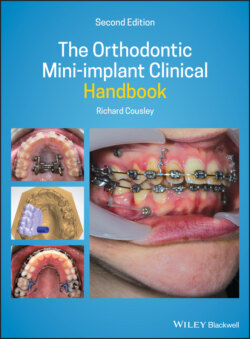Читать книгу The Orthodontic Mini-implant Clinical Handbook - Richard Cousley - Страница 36
2.3 Soft Tissue and Oral Hygiene
ОглавлениеClinical experience indicates that there are distinct differences in soft tissue thickness according to anatomical location. This has been borne out in a ultrasound study of soft tissue thickness at mini‐implant insertion sites, where the midpalate mucosa was the thinnest (mean 0.8 mm), followed by buccal sites (mean 1.3 mm) and palatal alveolar sites (mean 3.1 mm) [33]. In practical terms, these findings support the use of short‐neck mini‐implants in buccal sites and long‐neck versions in palatal alveolar sites. In theory, short‐neck mini‐implants could be used in the midpalate, but longer neck versions may be helpful here to provide a means of attachment by elevating the head position. However, there is no evidence relating attached tissue thickness and mini‐implant success rates per se.
Figure 2.3 Photographs showing typical peri‐implant soft tissue inflammation at (a) time of insertion in the right mandibular area and (b) after seven months of elastomeric traction. General problems with oral hygiene and resultant gingival hyperplasia are also evident.
What is known is that poor oral hygiene and peri‐implant soft tissue inflammation (Figure 2.3) are risk factors for secondary failure [34–39]. Since these problems are more likely to occur in loose (non‐keratinised) mucosa, it is almost always recommended that mini‐implants are inserted through attached mucosa. This should minimise soft tissue disruption and the destabilising effects of mobile peri‐implant tissue. The zone of mucosa which lies immediately around (coronal or just apical to) the mucogingival junction (MGJ) has been popularised by Sebastian Baumgaertel as a potential site, but there are no published data on success rates in this specific area [40,41]. It is likely that the key ‘take home’ message is that insertions should be sited in attached gingiva sites, with the option of ‘straying’ into the loose mucosa adjacent to the MGJ, provided that the sulcular tissues are stretched taut. This avoids interference during the insertion stage, by preventing the loose mucosa from wrapping around the mini‐implant threads.
It is almost always recommended that mini‐implants are inserted through attached mucosa.
